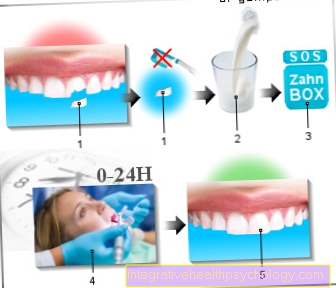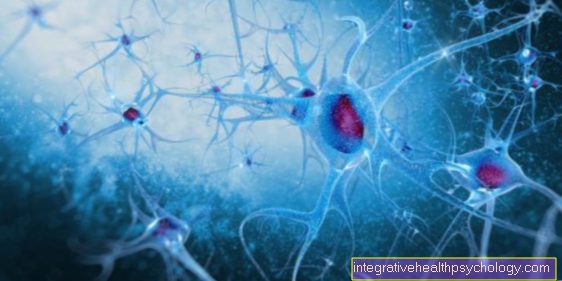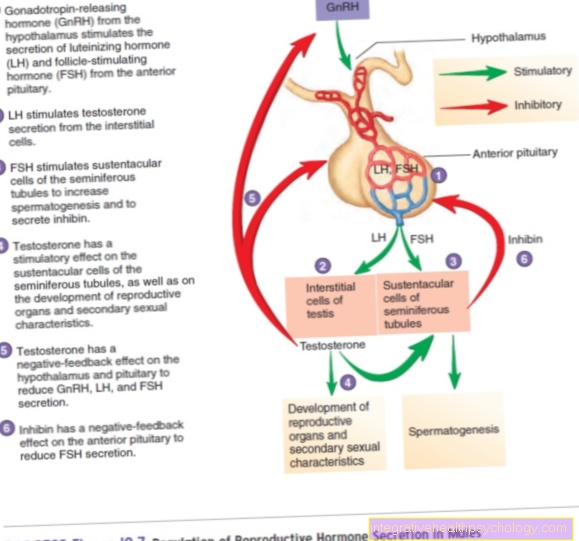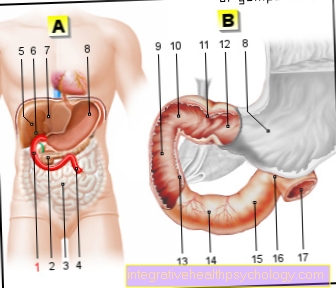Ferritin
Definition - What is Ferritin?
Ferritin is a protein that plays an important role in the regulation of iron metabolism. Ferritin is the iron storage protein. Iron is toxic to the body when it swims in the blood as a free molecule, so it has to be bound to various structures.
Functionally, iron is bound in hemoglobin, the red blood pigment, where it is important for the transport of oxygen. The rest of the iron is stored in ferritin. Most of the ferritin itself is stored in the liver cells, including the spleen and bone marrow.
However, ferritin is also found in other organs, such as the heart and brain, where it does not serve as a pure iron store.
Read more on the topic: Iron in the human body

What are normal ferritin values (norm values)?
The normal values for ferritin vary depending on age and gender.
The limit values for men are slightly higher than for women: between 18 and 50 years of age, the value should be between 30 and 300 ng / ml, then between 5 and 660 ng / ml.
For women between 16 and 50 years of age, the normal range is between 20 and 110 ng / ml, after which the ferritin value should be between 15 and 650 ng / ml.
Newborns and infants have a normal range for ferritin of 90 to 630 ng / ml, with increasing age the normal range initially drops to 40 to 220 ng / ml.
Reasons to determine ferritin in the blood
Ferritin should be determined in the blood if existing symptoms indicate a ferritin value outside the normal range. The ferritin can be either too high or too low. Both deviations initially have very unspecific symptoms in common, resulting in tiredness, exhaustion and reduced physical performance.
If there is a ferritin deficiency, there is usually iron deficiency anemia (anemia). Iron and the other substances involved in iron metabolism (hemoglobin = red blood pigment, erythrocytes = red blood cells, transferrin = iron transport protein) are mostly changed beyond their normal values.
Further indications of such anemia can be pronounced paleness, increased coldness and sleep disorders, as well as headaches and tachycardia (rapid heartbeat). In this case not only the iron value but also the ferritin should be determined. The iron provides information about the currently usable iron content, if the ferritin is also reduced, this indicates a long-standing iron deficiency, since the iron stores are also empty.
Read more on the topic: Symptoms of iron deficiency anemia
Ferritin should also be determined if there is evidence of iron storage disease. These go hand in hand with very high ferritin levels and in the long run can lead to dangerous liver damage. In addition, they promote the development of liver tumors, which is why the ferritin value should be determined if they are suspected.
Read more on the topic: Storage diseases - what are they?
How is transferrin in the blood determined?
Transferrin is also a protein that plays an important role in iron metabolism. Transferrin is usually determined together with hemoglobin, erythrocytes, serum iron and ferritin in the diagnosis of iron deficiency anemia.
You can determine the transferrin level just like the other values from the blood. The normal value of transferrin is 200 to 400 mg / dl. In addition, the transferrin saturation can also be determined. This indicates which part of the transferrin is occupied with iron particles at a certain point in time. Iron transferrin saturation is usually around 25%.
Read more on the topic: Blood count
evaluation
The ferritin value in the blood is evaluated depending on the age and gender-specific norm values. In addition, the other iron metabolism values should also be included in the evaluation.
In most cases, a decreased ferritin level is accompanied by a decreased erythrocyte concentration, a decreased hemoglobin value and a decreased serum iron. The transferrin, on the other hand, is usually increased in such cases, as the body tries to absorb as much iron as possible from the intestine with the help of the transferrin.
On the other hand, hemoglobin, iron and erythrocytes are often increased when ferritin levels are increased. The transferrin level, however, is reduced.
Ferritin Too Low - Causes?
There are many reasons why the ferritin can be too low. The origin is usually a pronounced iron deficiency, which can be triggered by insufficient iron intake. Alternatively, an increased iron requirement or blood loss and thus also the loss of iron are the reasons for a ferritin deficiency.
Since iron is absorbed through the gastrointestinal tract, it is important to have a sufficient amount of iron in the diet. Iron is mainly found in red meat, but legumes are also high in iron. In addition, iron absorption from food can be disturbed if the intestine is not supplied with sufficient vitamins (especially vitamin C).
In endurance athletes, children and pregnant women, the iron deficiency can also be due to an increased need. Endurance athletes are affected in particularly intensive training phases, children and adolescents can suffer from iron deficiency if they are in a pronounced growth phase. In pregnant women, the iron requirement increases up to three times the normal requirement. During pregnancy, the requirement is still twice as high as in the normal case.
Iron loss is mostly caused by blood loss. This can be chronic bleeding, for example in the gastrointestinal tract. Women in particular are often affected by a ferritin deficiency because they lose blood every month through menstruation. Large blood losses, such as those that occur in an accident or long operations, can also be the cause of a ferritin deficiency. In newborns who have to stay in hospital for a long time, the iron deficiency can also be caused iatrogenically (by doctors), since the little ones often have to have blood drawn.
Read more on the topic:
- Causes of Iron Deficiency
- Menstrual irregularities
- Endurance sports and nutrition
Ferritin too high - causes?
There are numerous causes for a too high ferritin value. Depending on the underlying disease, a more extensive diagnosis should be carried out if there is an excess of ferritin.
So there are many harmless causes of the ferritin increase. For example, ferritin, a so-called acute phase protein, increases in the acute phase of inflammation. Too much ferritin can therefore be triggered by infections, colds or the flu. Autoimmune diseases are also accompanied by inflammation in the body, so that they can cause the ferritin level to rise.
You might also be interested in this topic: Inflammation levels in the blood - what do elevated levels indicate?
If the erythrocytes (red blood cells) are severely damaged, a large amount of iron is released into the blood. In order to bind this iron, the body produces additional ferritin and thus increases the ferritin value. A high ferritin level can also occur with malnutrition, and an overdose of iron tablets can also lead to high ferritin levels.
Causes of increased ferritin that require clarification are diseases of the liver or iron storage diseases. Inflammation of the liver (hepatitis, liver cirrhosis) or liver tumors can increase ferritin by damaging the liver cells. This releases the ferritin into the blood. Iron storage diseases or hemochromatosis, for example, which are associated with increased absorption (uptake) of iron from the gastrointestinal tract, can also cause ferritin to skyrocket.
You can find more information on elevated ferritin levels on the following page: Ferritin level too high
Transferrin determination costs
The costs for a transferrin determination depend on the responsible health insurance company and the laboratory. In addition, you have to calculate the costs for taking the blood sample and sending the blood tube.
If the indication is sufficient, the transferrin can be taken as part of a normal anemia determination (including erythrocytes, serum iron, hemoglobin and ferritin), so that hardly any additional costs are incurred. The costs for the determination are covered by the health insurance company, provided there is a sound medical indication for the transferrin determination.
Please also visit our main page on the topic: Transferrin
What to do if transferrin values are changed
Changes in transferrin levels can have different causes. The transferrin in the body is increased when there is an increased need for iron in the body. This is the case, for example, with pregnant and breastfeeding women, and children and adolescents also have an increased iron requirement in the growth phase. Even with a normal iron deficiency, the transferrin value increases. In most cases it is enough to get more iron from food. ly meat products, but also green leafy vegetables, legumes, oat flakes and soy should be eaten.
If iron cannot be normalized with this, or if the ferritin level remains elevated, taking iron tablets can improve the symptoms. In rare cases, iron must be given through a vein or an injection into the muscle. These forms of application lead to a significantly faster absorption of the iron.
A reduced transferrin level, on the other hand, is usually not so easy to treat. It can be an indication of chronic inflammation, autoimmune diseases, iron storage diseases or tumors. In this case, a detailed diagnosis should first be carried out, with the help of which the cause of the lowered transferrin value can be found out. Adequate therapy can then be initiated.
You might also be interested in these topics:
- Diet for iron deficiency
- This is how you fix an iron deficiency
Is ferritin also a tumor marker?
In addition to iron deficiency symptoms or iron storage diseases, ferritin can also indicate chronic inflammation or tumor diseases.
As an acute phase protein, the ferritin value increases sharply in acute inflammation in the body. But even with chronic inflammation such as autoimmune diseases, the ferritin is increased. In the case of a tumor, the body reacts in the same way as it does to an inflammation, so the ferritin also rises in this case.
In most cases the ferritin does not form a specific tumor marker.Rather, the increased ferritin value indicates that a process is going on somewhere in the body that is being processed by the immune system. For many general tumor diseases and blood cancers, increased ferritin can be an indication.
Since the ferritin is mainly stored in the liver, a significantly increased ferritin value can also indicate liver cell cancer. Due to the destruction of liver cells as part of the tumor disease, a lot of ferritin is released from the cells, this is washed out into the blood and can be measured there in increased concentration. But a tumor is by no means the only cause of liver cell damage. The increased ferritin can also be a sign of liver cell damage due to liver inflammation (hepatitis) or fatty liver (Cirrhosis of the liver) be. Both diseases favor the development of liver tumors and should therefore be treated at an early stage.
Read more on the topic: Tumor markers
What is the relationship between ferritin and transferritin?
Ferritin and transferrin are basically two opponents that regulate each other. Normally, the two proteins involved in iron metabolism are in balance. However, if there are disturbances in the iron metabolism, the concentrations of the two proteins can change quickly.
A low ferritin value, for example, is an expression of an iron deficiency. The body is stimulated via feedback mechanisms to produce more transferrin. This is the only way to regain increased iron absorption from the gastrointestinal tract. As a result, the iron level rises, the ferritin level also rises and the transferrin concentration can decrease again.
Conversely, increased ferritin is the expression for an excess of iron. In return, the availability of transferrin is down-regulated so that less iron is absorbed from the diet. However, disruptions in this regulation can still lead to a constant or increasing supply of transferrin. This additionally increases the iron concentration in the body and can lead to excess iron.











.jpg)














.jpg)


